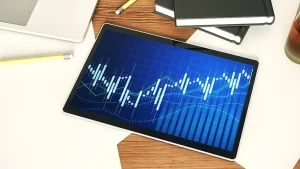- About
- Offerings
- Tools
- Pricing
- Partner
- GyanHub
- Resources

What are Bollinger Bands? The volatility of a financial asset, such as a stock, commodity, or currency, can be determined using the technical analysis tools known as Bollinger Bands. It was created in the 1980s by John Bollinger and had three lines. A simple moving average (SMA) of the price over a predetermined amount of time is represented by the middle line (usually 20 days). The upper band is made up of the same SMA plus a particular number of standard deviations (often 2) of the price during the same time period. The lower band is the same SMA minus the same amount of standard deviation of the cost during the same time period. Typically, the upper and lower bands are designed to be two standard deviations from the moving average, although this can be changed depending on the asset’s volatility.
Here, you read about the Bollinger bands. Later in this article, you will read about the Bollinger Bands trading strategy, its formula, and its working.

Many people are now trying their hand at margin trading and short selling. Trading on margin is borrowing money to purchase securities. On the other hand, short selling involves selling assets and purchasing them again at a lower price. Investors’ potential to boost their purchasing power in the market is made possible through leverage. They increase their purchasing power by agreeing to a margin loan with their broker. The capacity to invest in more stock than they could normally do with their own money.

All forms of trading provide the potential for investors to earn. This tutorial will concentrate on position trading, which entails maintaining a position for a long time to increase the likelihood of generating a profit. This article explores what is positional trading and how it functions, provides advice for creating powerful position trader techniques and lists the benefits and drawbacks for a novice or seasoned investor.

When you enter stock trading, you come across various subsets and styles of trading; equity trading, F&O trading, intraday trading, delivery trading, etc. Regardless of segment or style, you will see your trades appear in at least one of the two, the order book or trade book. To know what an order book and trade book are you can read the following information.

Today, Indians, both young and old, want to learn about stock market investing. That is because, with each passing day, more people are learning about the benefits of investing in the stock market; they are coming to understand that the stock market is one of the best ways to generate long-term wealth. However, that said, successful wealth creation in the stock market is only possible if you have a well-defined plan to create an online trading portfolio that suits your investor profile.

An effective technical analysis tool for identifying trends and probable entry and exit points for buying or selling a specific company is the moving average. The average stock price for a predetermined amount of time, such as 10 days, 50 days, or 200 days, is used to compute the moving average. The line that results, when displayed on a graph, depicts the trend of the stock price during that time. Moving averages are helpful for traders because they may show them trends and possible entry and exit points. For instance, a company is deemed to be in an uptrend if it is trading above its 50-day SMA or 200-day SMA, and traders may try to purchase the stock on any declines. On the other hand, a stock is said to be in a downtrend if it is trading below its 50-day SMA or 200-day SMA. Traders may then try to sell the stock on any gains.

You may have heard about moving averages. However, have you encountered the term “moving average convergence divergence (MACD)”. In this article, we shall discuss what the MACD indicator is. The MACD indicator is very useful to trace the momentum, direction of a stock’s price in a trend. The MACD crossing is a crucial signal. Histograms that compare the MACD line and the signal line are used to study the features of convergence and divergence.

A trader must get the best price while placing an order on the stock market. A seller wants to sell a stock for as much money as possible, and a buyer always wants to purchase a stock for as little money as feasible. So, there are many ways and approaches for handling stock market trades that can help you to maximize profit and reduce loss. A limit order is the most effective instrument for building successful investing strategies. Limit orders often protect your portfolio from losses caused by irrational price changes. The article will continue to discuss what a limit order is in the stock market.

If you are someone who keeps mixing up the operating margins with the EBITDA margins, you just have to remember one thing: The EBITDA is obtained by removing the cost related to depreciation and amortisation from the operating margin.
Conversely, if you’re a beginner, a company’s operating profits and EBITDA are key financial parameters, just like the company’s revenues and profits. Even as a beginner, you understand the importance of metrics like the company’s revenue and profits. “Operating profits” and “EBITDA” may seem convoluted compared to the revenue and profit metrics, but they are equally important parameters.
If you wish to analyse a company’s financial health and profit-generating ability holistically, you must learn to look beyond its revenues and profits. So, let’s uncover these metrics, distinguish them, and understand their importance.

Each trader enters the market with the intention of making money. As a trader, you must support your decisions with thorough investigation and analysis. Take a number of aspects of the scripts you are investing in into account, including the company’s success, its management, planned announcements, etc. You can also use a variety of tools, charts, patterns, and technical indicators to analyze your investments. An informative introduction to the Ichimoku cloud indicator is what you will be reading next.

A moving average (MA) is a simple yet effective technical indicator that shows you the average price of a stock during a specific period. That period could be 10 days, 15 minutes or 40 weeks. On the price chart, the moving averages appear in the form of a smooth line representing the average price.
Traders refer to the moving average to gauge the stock’s trend. Furthermore, they can use that data to make informed buying and selling decisions. When it comes to buying stocks using a moving average, traders are primarily looking for crossovers. Some traders even make purchasing decisions based on moving averages that are strong supports.
Moving average strategies can be adjusted to different timeframes, making them suitable for long-term and short-term traders. Let’s expand on the key aspects you must be aware of before using the MA to buy stocks.

In technical analysis, a head and shoulders pattern is highly employed. It’s a unique chart pattern that signals a change in trend from bullish to bearish. There are three parts to a head-and-shoulders pattern. After a protracted bullish trend, the price climbs high before falling to create a trough. The price increases a second time, much beyond the first high, and then declines again. The price increases again, but only to the initial peak before falling. The shoulders are formed by the first and third peaks, while the head comprises the second peak. The neckline is the line that divides the first and second troughs. In the opinion of most traders, one of the most reliable trend reversal patterns is the head and shoulders chart pattern.
It predicts when an upward trend is about to finish. Textbook head and shoulders patterns are rare, but most traders think they signal a significant trend reversal when they appear. A typical head and shoulders formation is seen as a bearish setup.